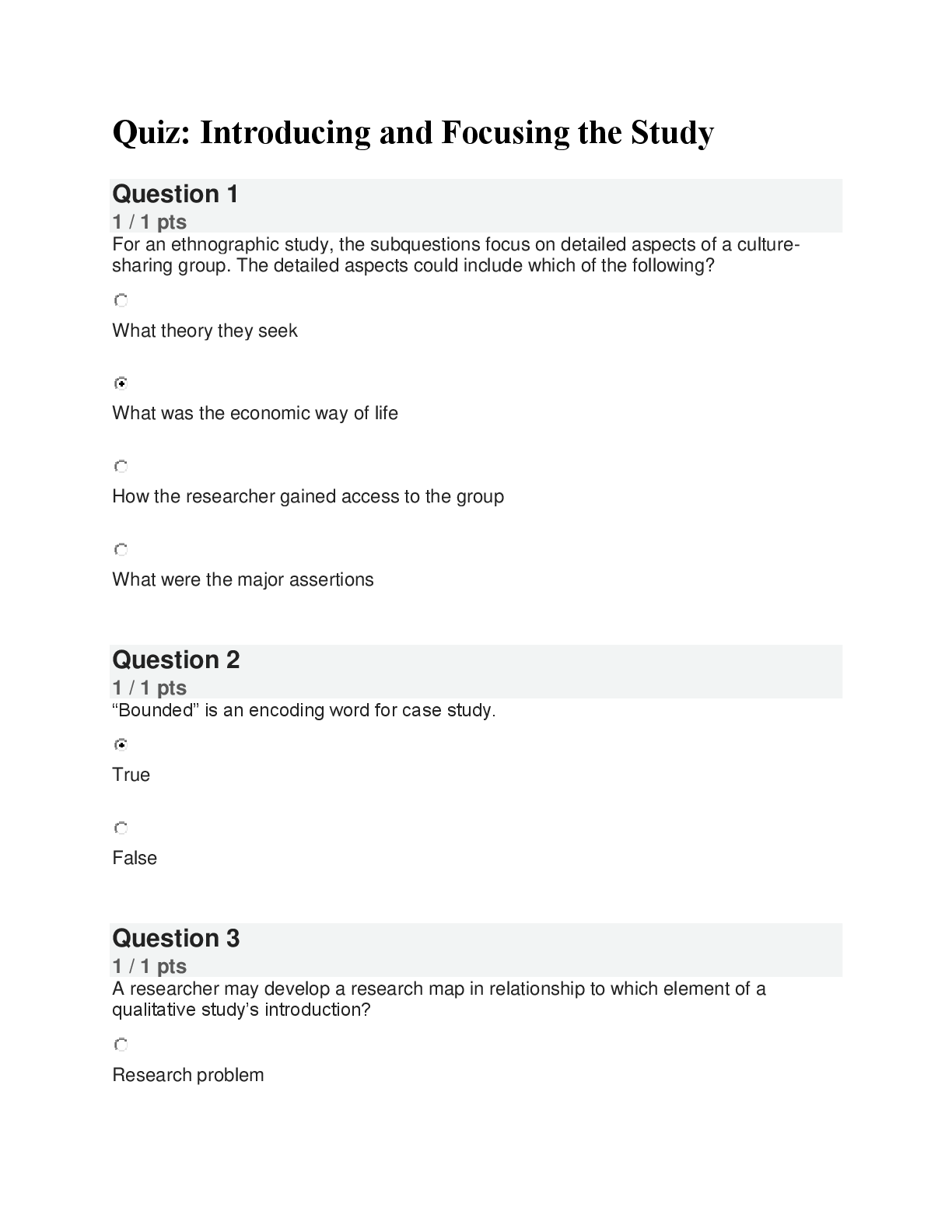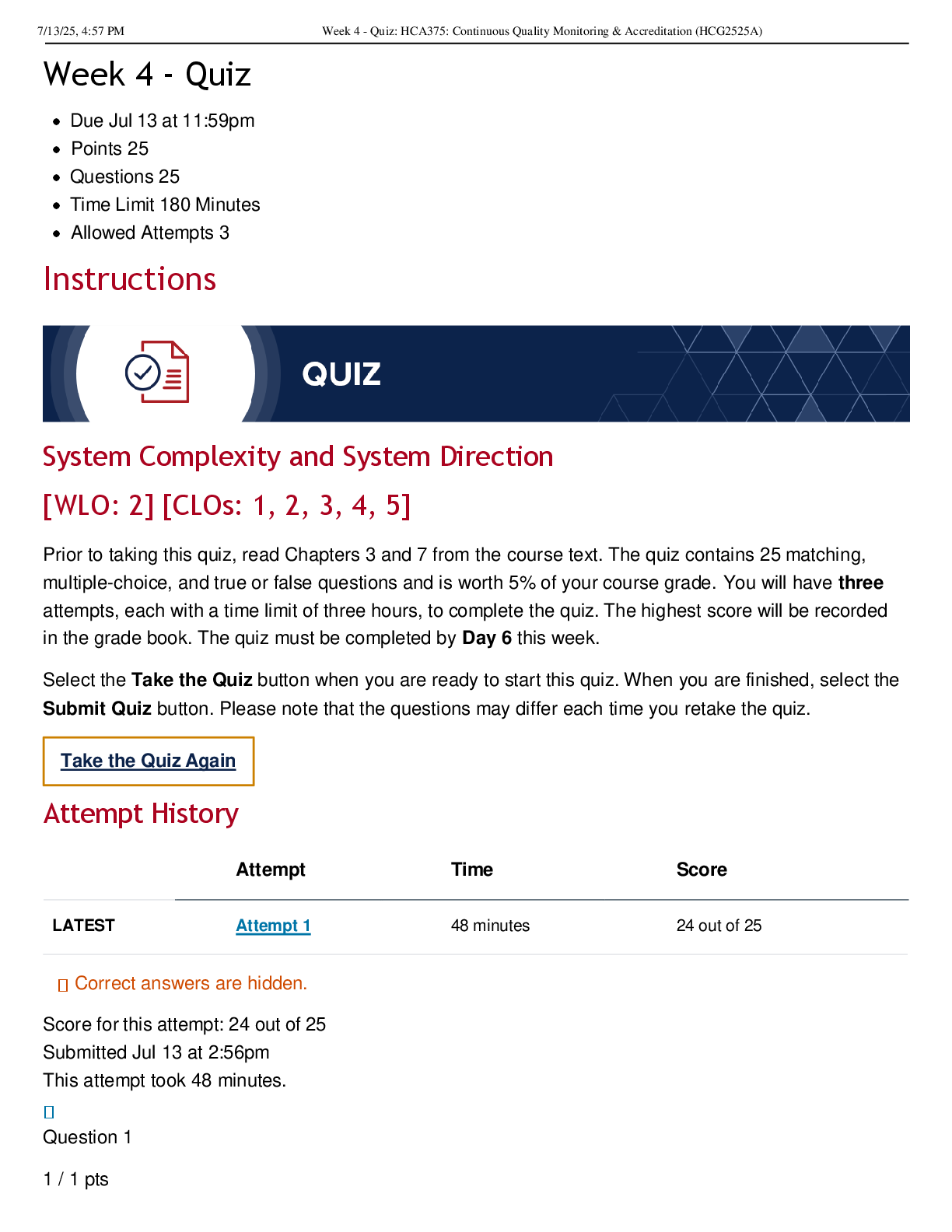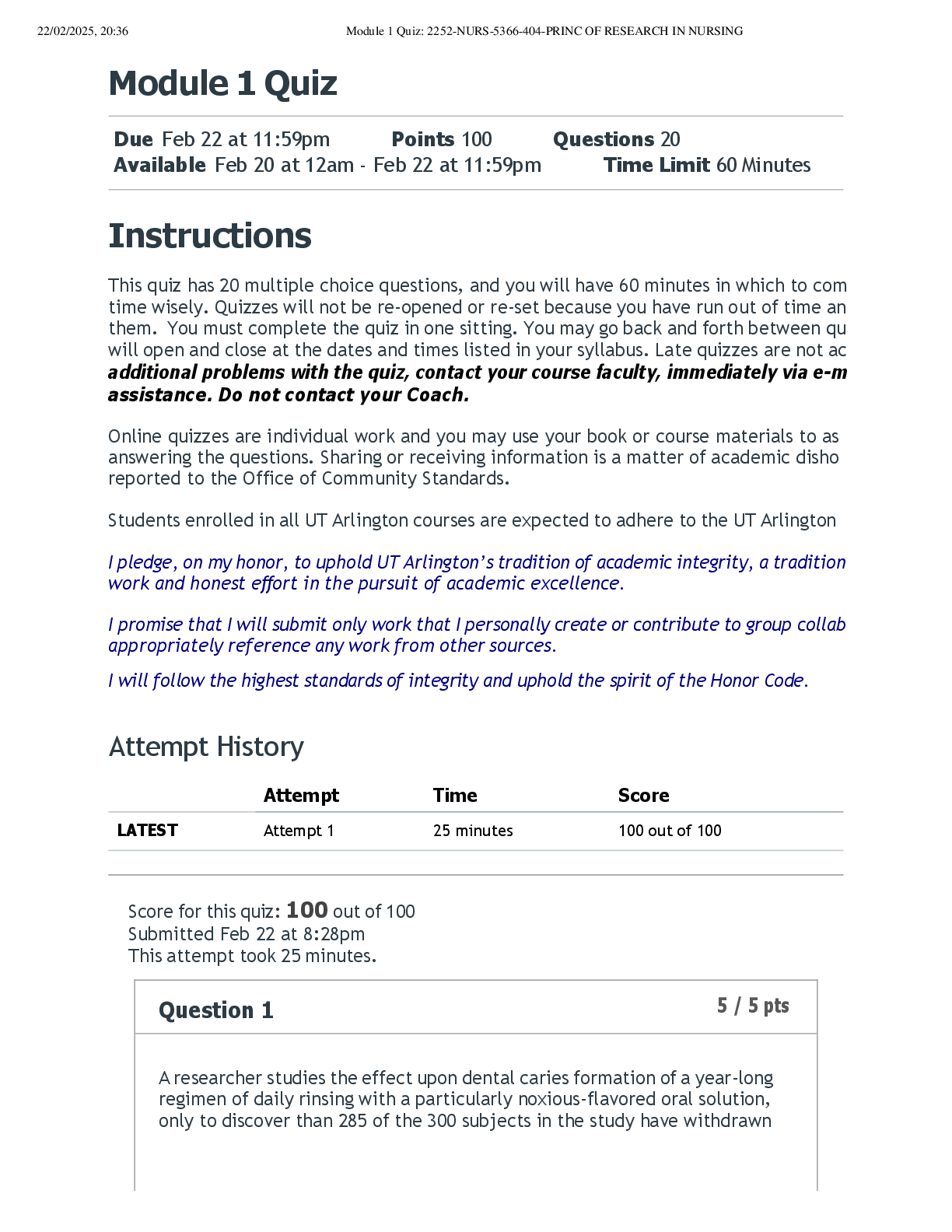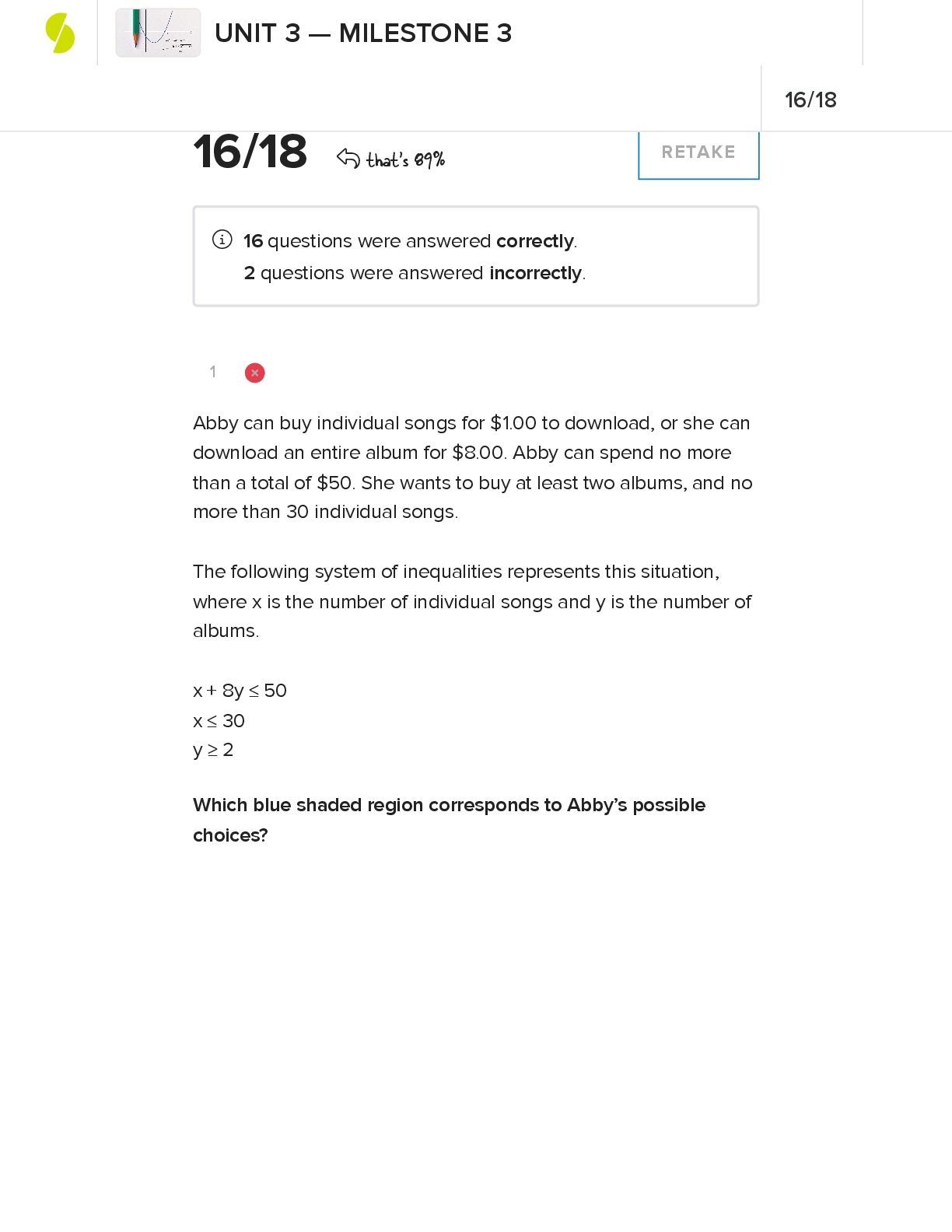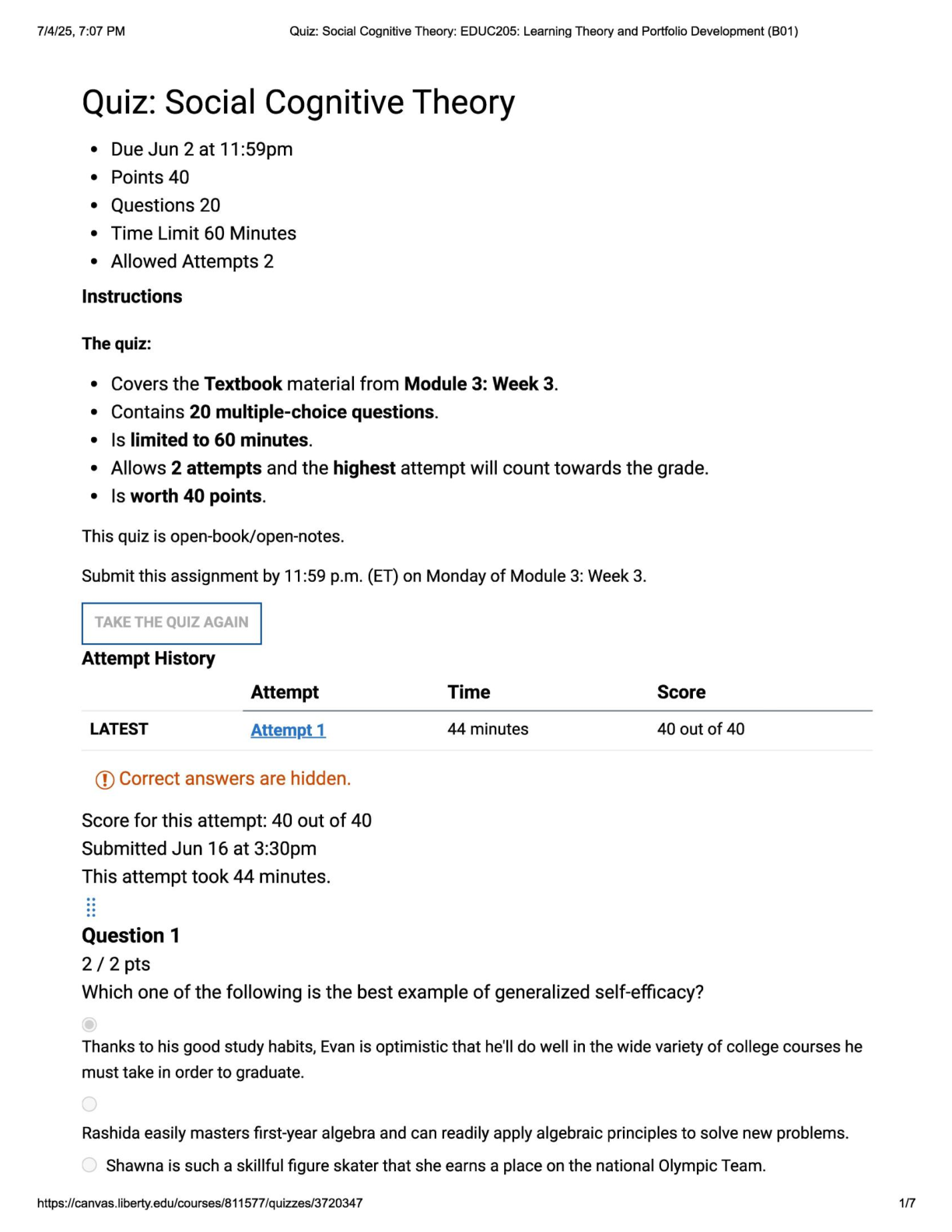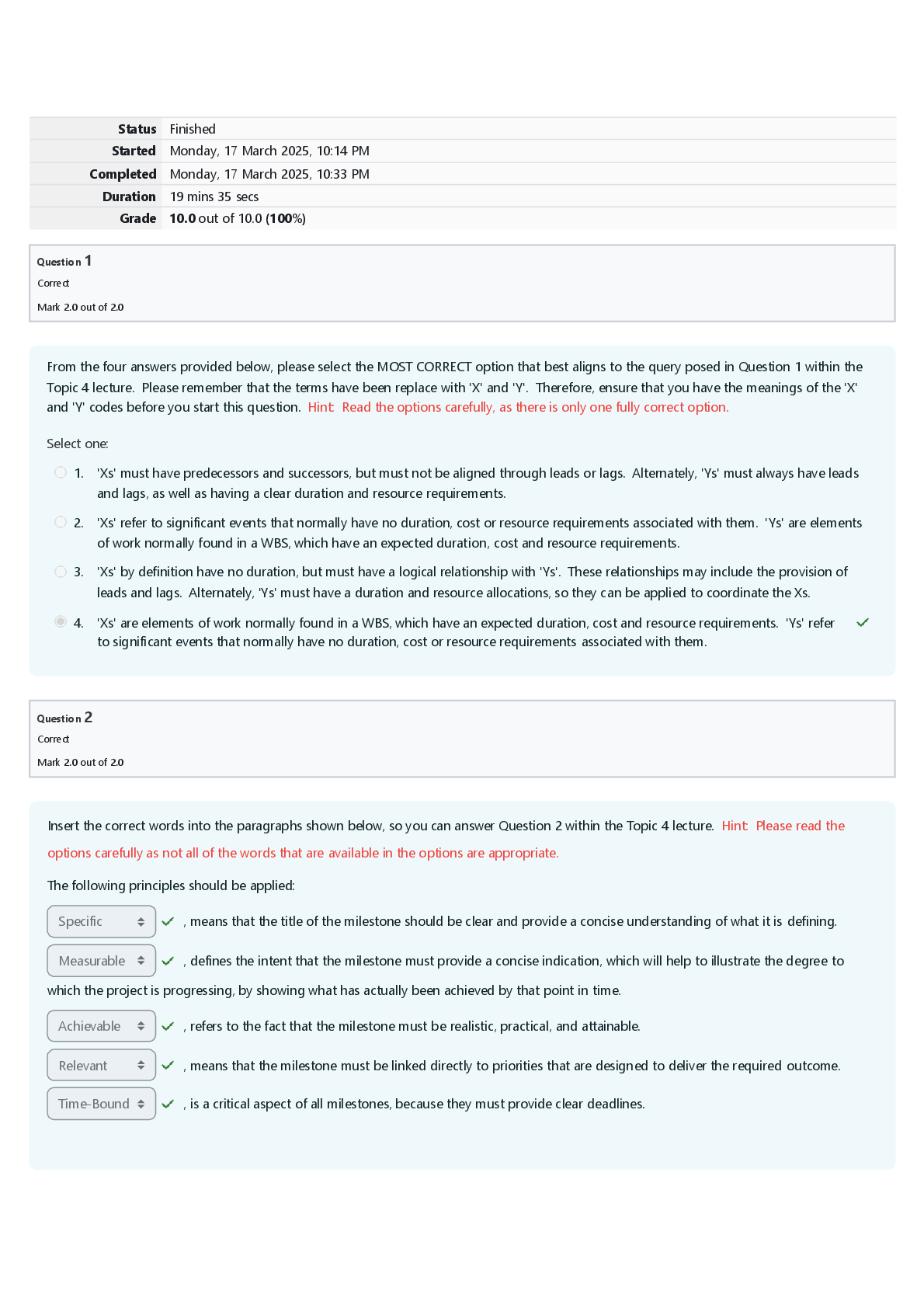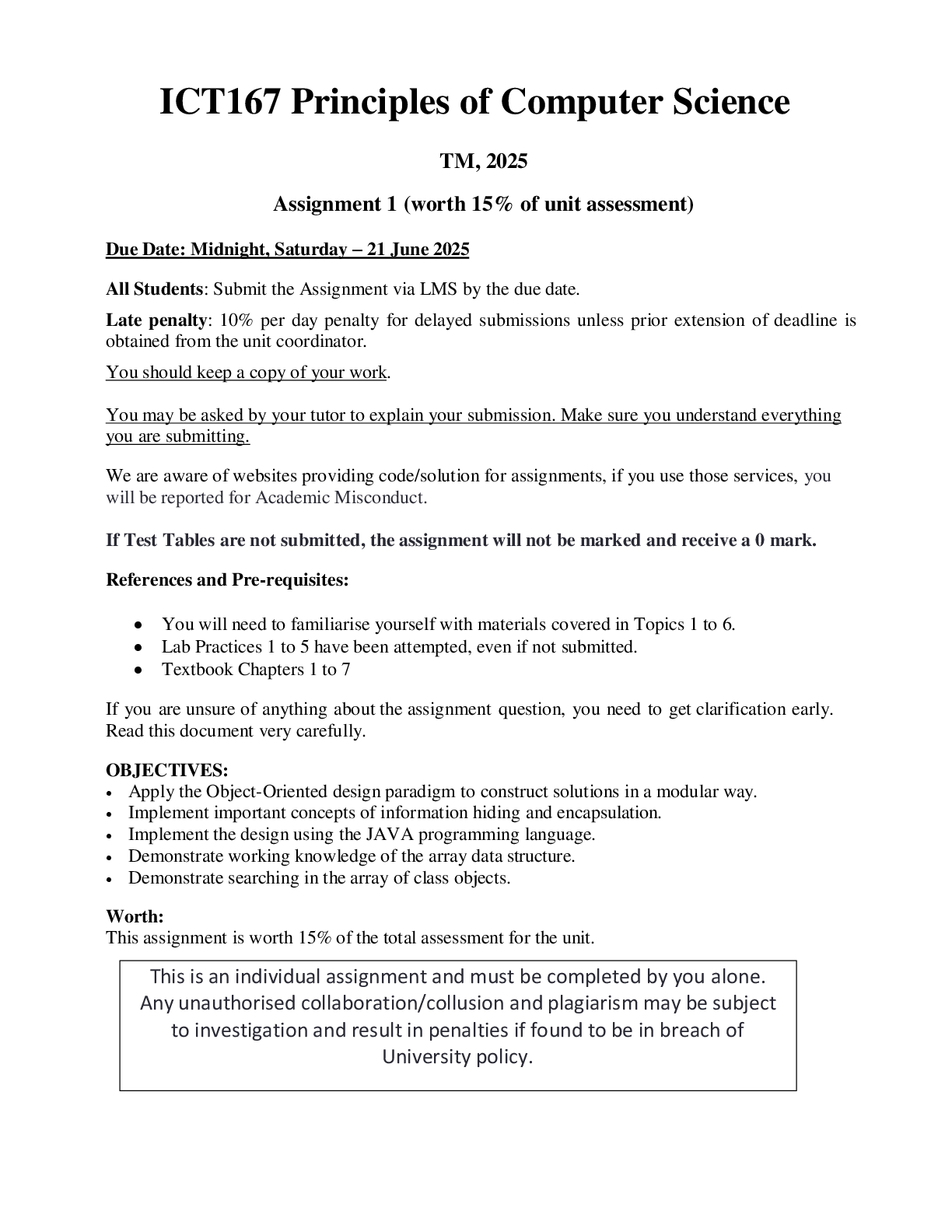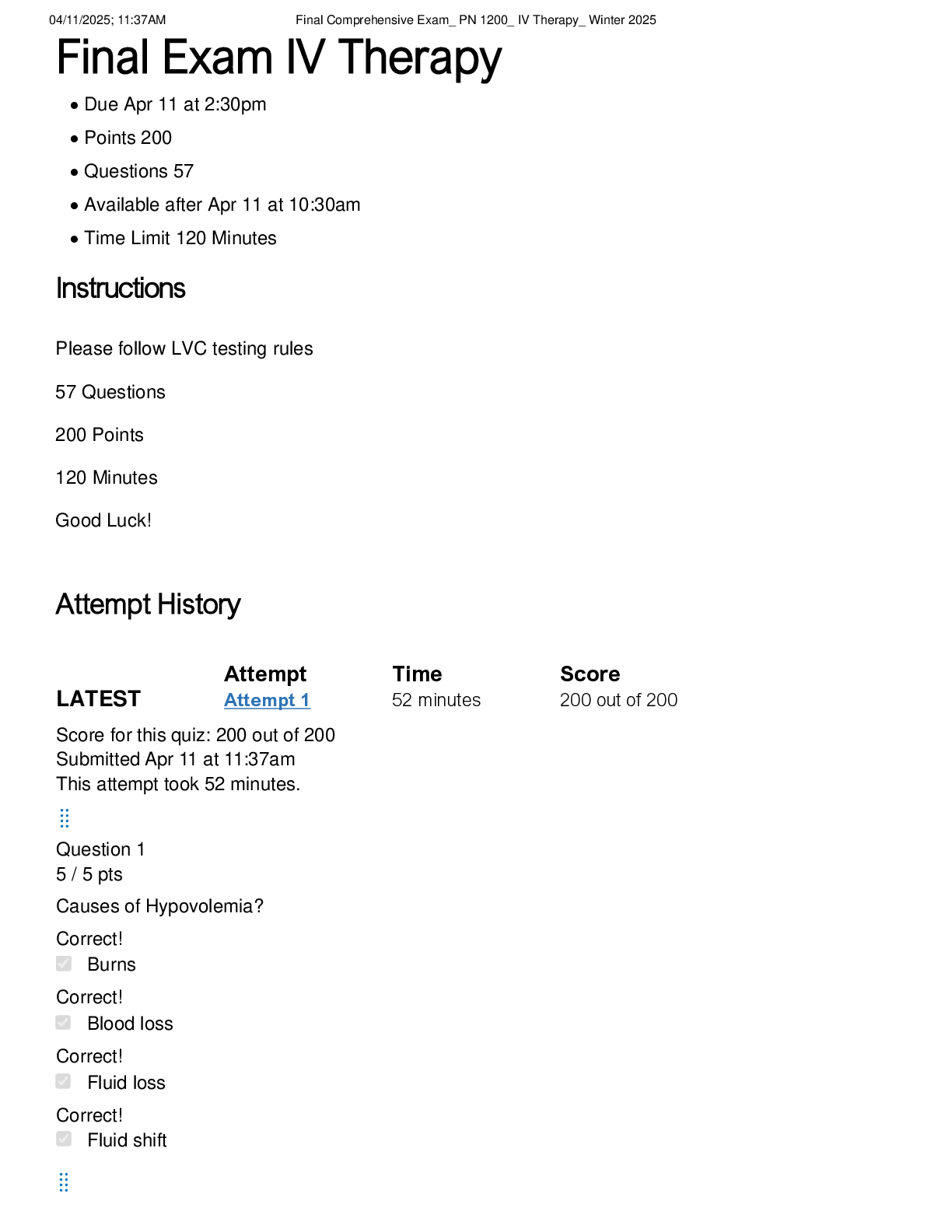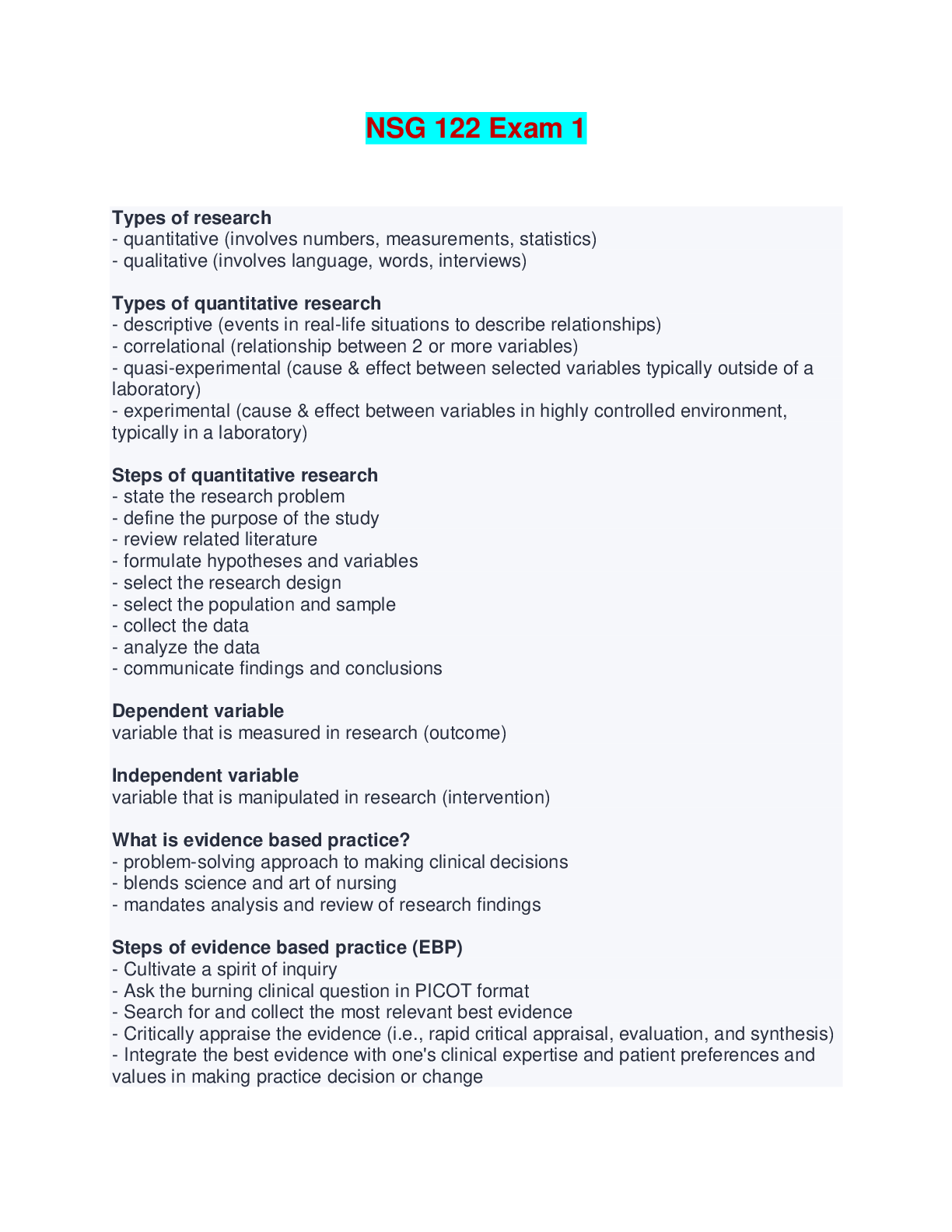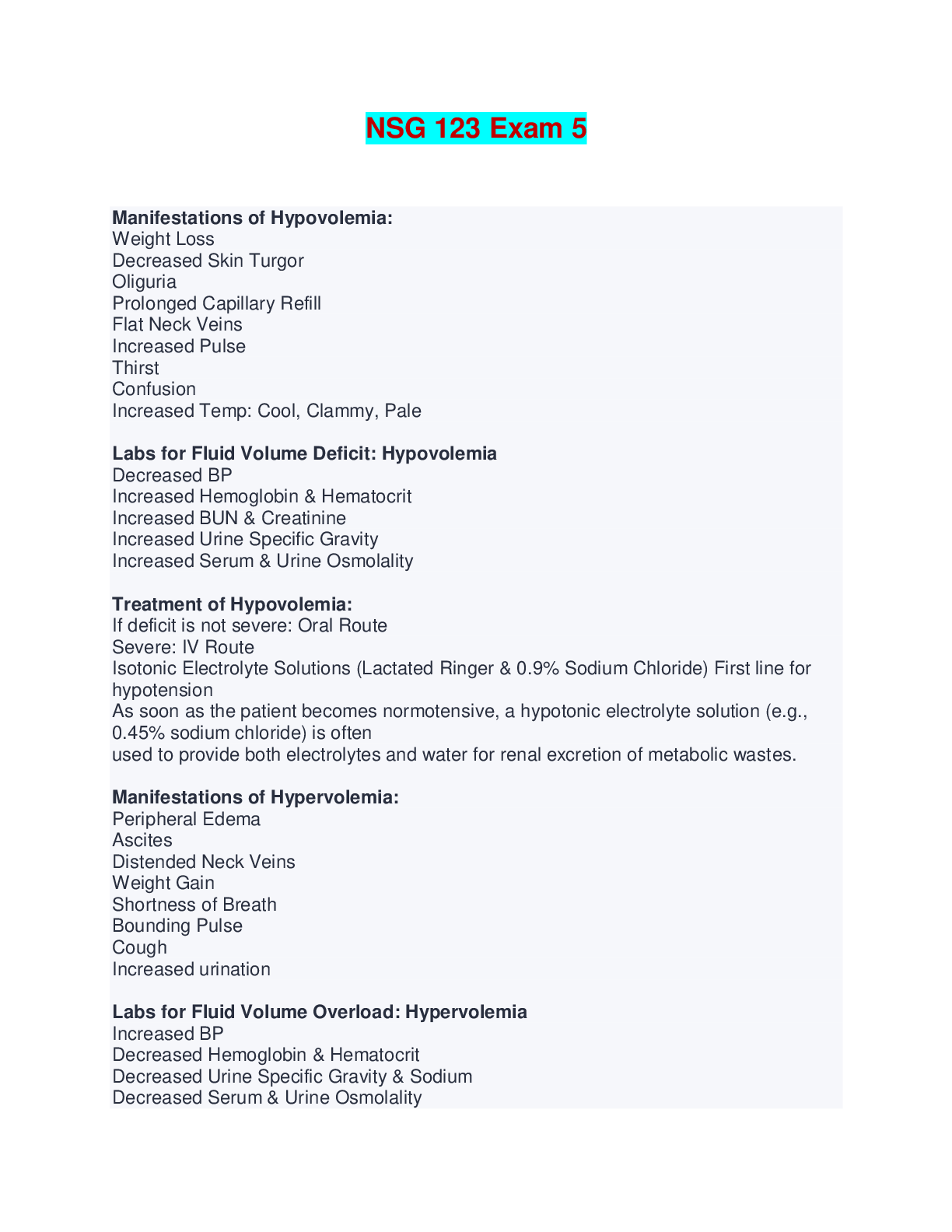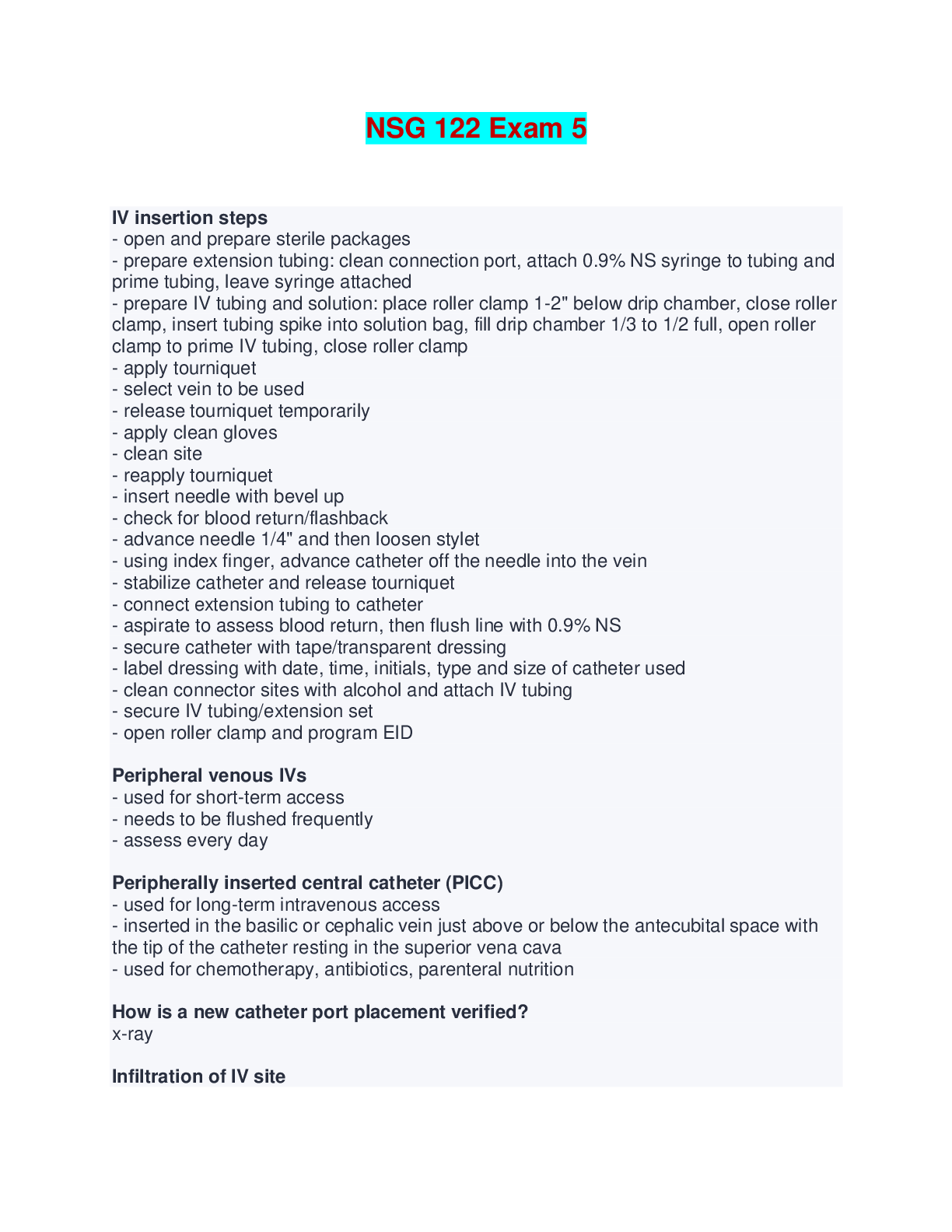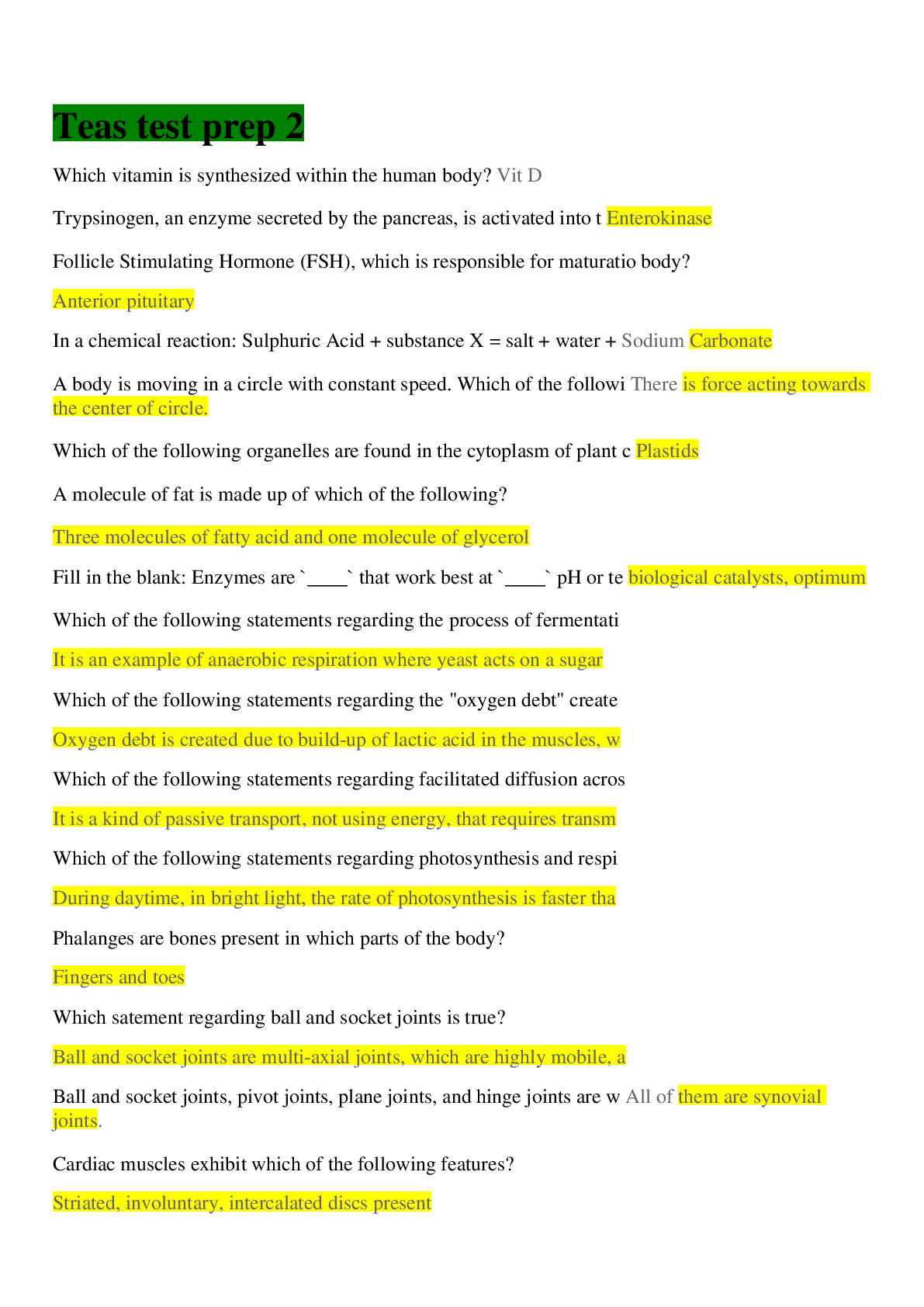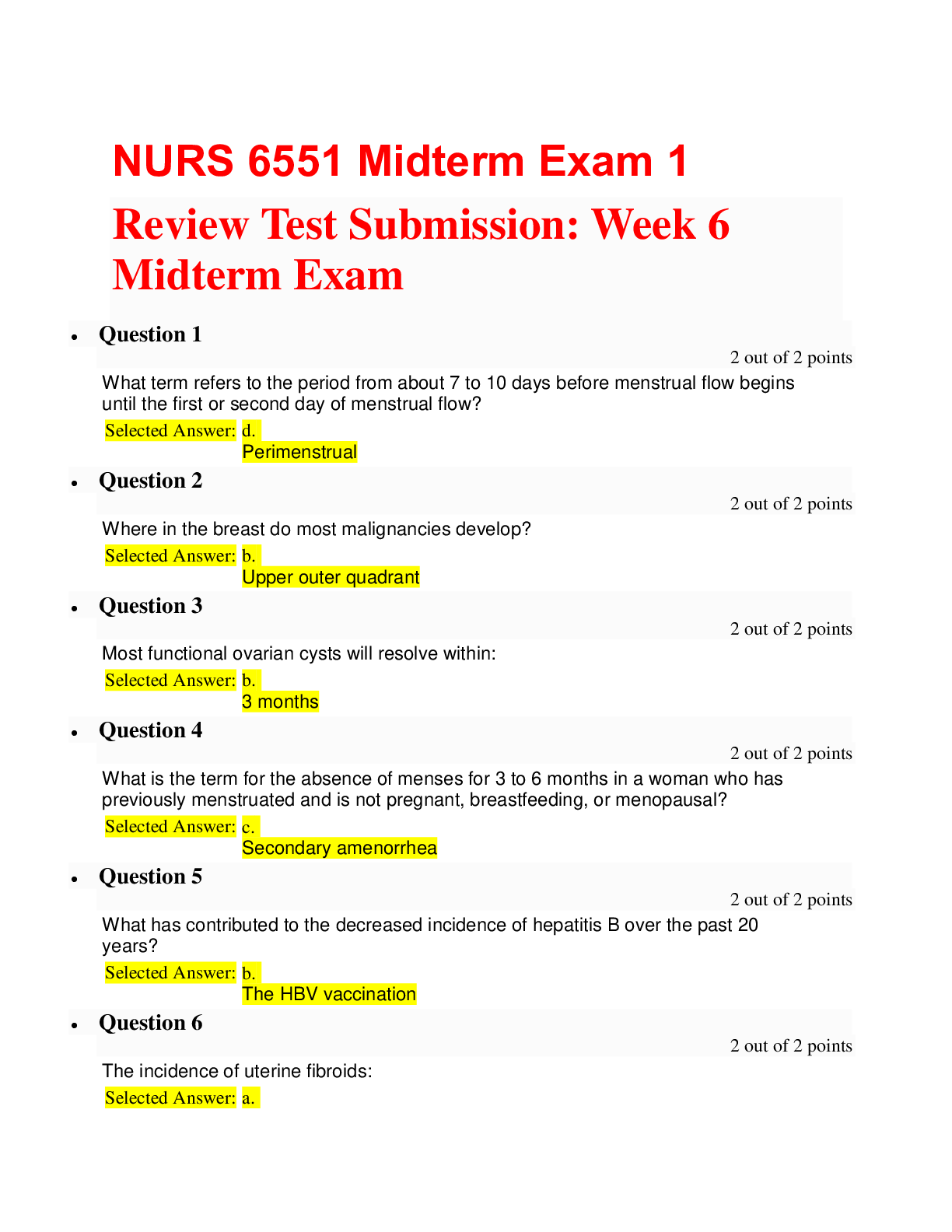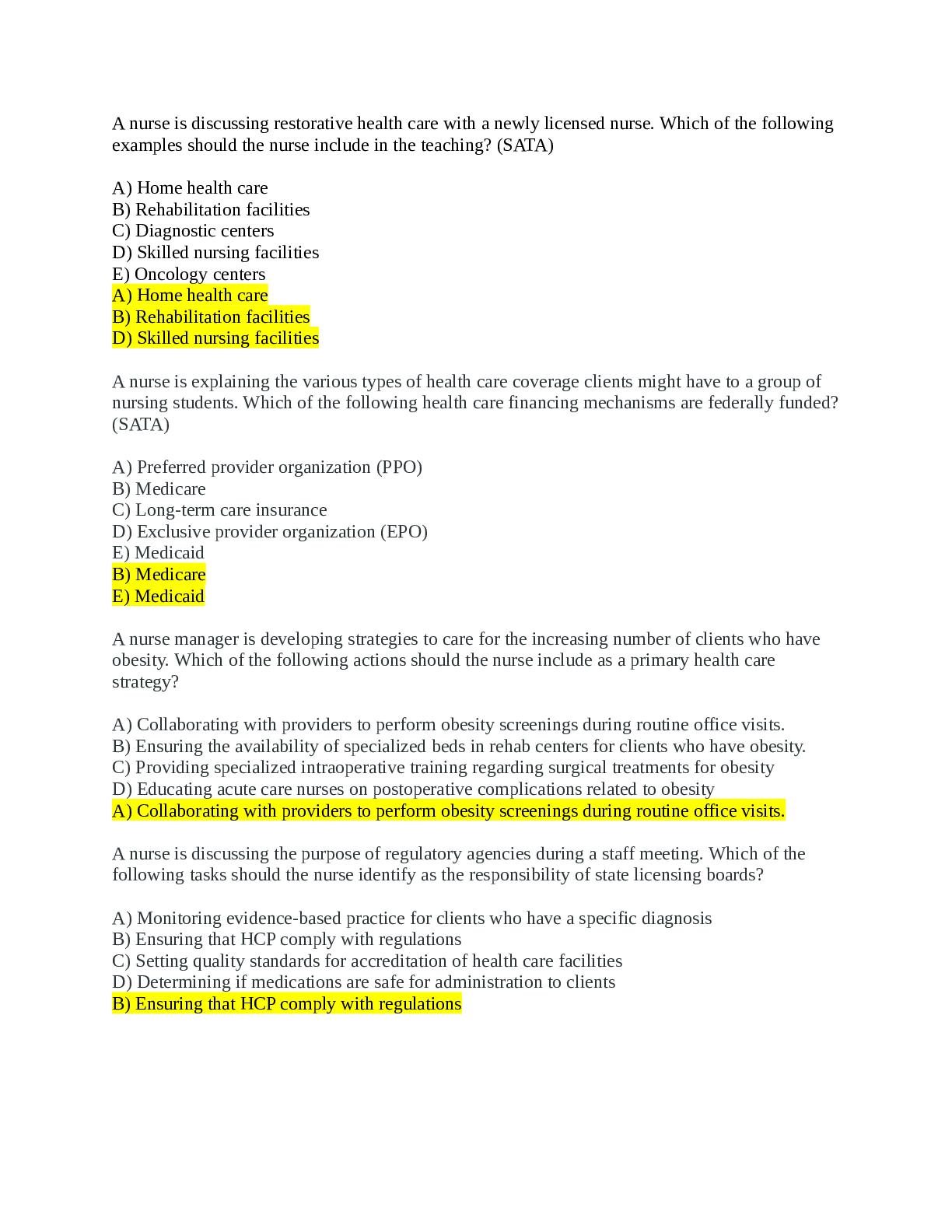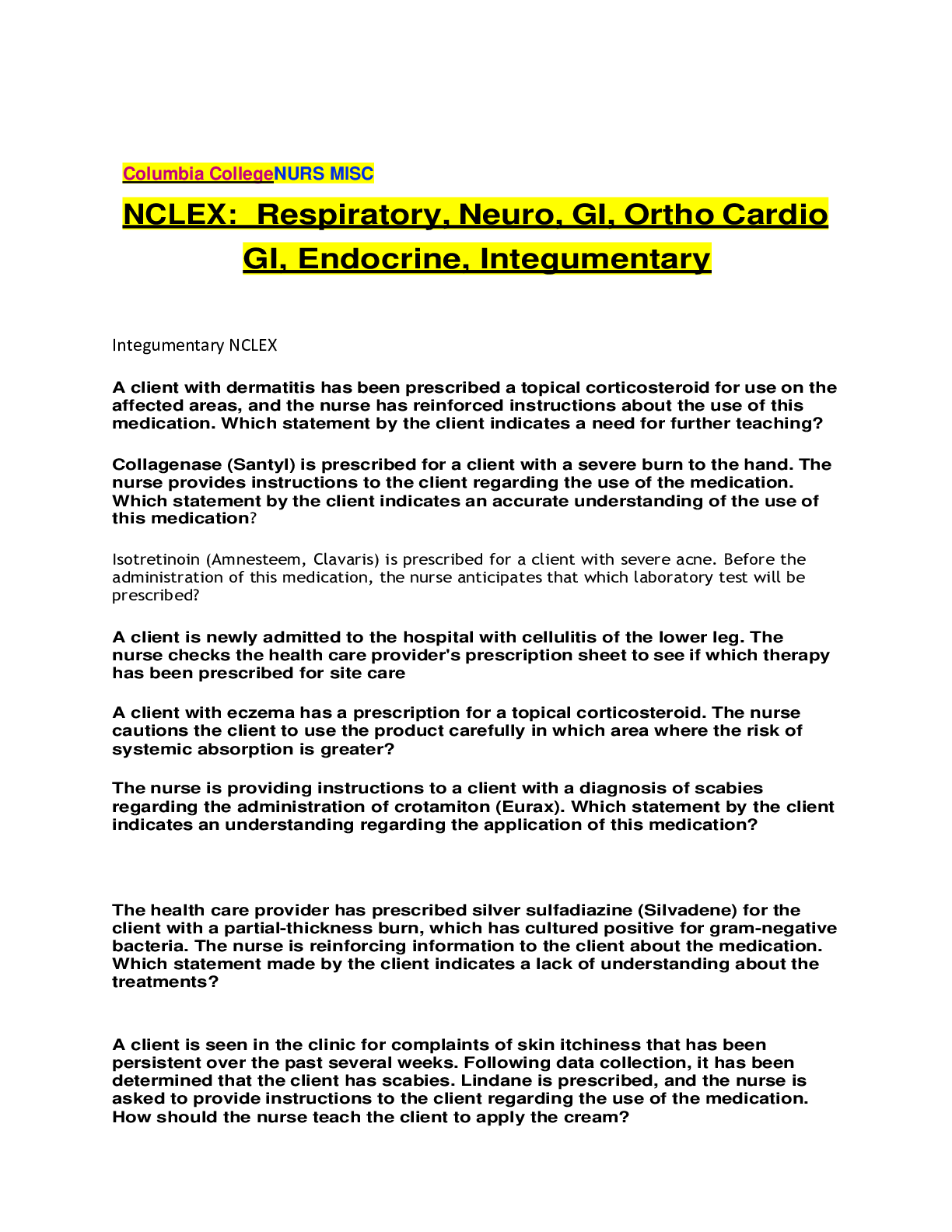PEDIATRIC (PEDS) HESI > EXAM > 2024/2025 Peds HESI Exam (Version 2) | Verified with 100% Correct Answers (All)
2024/2025 Peds HESI Exam (Version 2) | Verified with 100% Correct Answers
Document Content and Description Below
2024/2025 Peds HESI Exam (Version 2) | Verified with 100% Correct Answers "A mother tells the nurse that her child does not want anything to do with toilet training and yells "NO!" consistently whe... n she tries to toilet train. The child is 2 years old. According to Erikson, the nurse interprets that the child is experiencing which psychosocial crisis?" a. autonomy vs shame and doubt b. initiative vs guilt c. industry vs inferiority d. trust vs mistrust A 2-year-old child is admitted to the hospital with juvenile rheumatoid arthritis (JRA). During the focused assessment, the nurse makes it a priority to note the presence of which of the following?" a. increased irritability and the child's insistence to be carried out b. complaints of joint stiffness c. history of daily temperature elevations d. description of how difficult it is to move around after periods of inactivity A mother of a toddler who is hospitalized with mild dehydration must leave her child to go to work. Which behavior would the nurse expect to observe in the toddler immediately after the mother's departure? a. silently curled in bed with a blanket b. loudly crying and kicking both legs c. playing quietly with a favorite toy d. sucking thumb and rocking back and forth "A newborn infant is diagnosed with hypospadias, and the mother asks the nurse about the disorder. The nurse bases the response on which of the following?" a. it is a congenital anomaly in which the actual opening of the urethra meatus is below the normal placement on the glans penis b. it occurs when one or both testes fail to descend through the inguinal canal into the scrotal sac c. it is a congenital anomaly in which the actual opening of the urethral meatus is dorsal to the urethral opening d. it is a congenital anomaly characterized by the extrusion of the urinary bladder to the outside of the body A home care nurse is providing instructions to a child with cystic fibrosis about how to perform the "huff" maneuver; the child asks the nurse about the purpose of this type of breathing. The nurse makes which response to the child? a. "this type of breathing is used to mobilize secretions so that they can be easily coughed out" b. "this type of breathing prolongs inspiration time" c. "this type of breathing moves air out of the lower lungs" d. "this type of breathing moves air through the lungs" A home care nurse is instructing the mother of a child with cystic fibrosis (CF) about the appropriate dietary measures. The nurse tells the mother that the child needs to consume a: a. low calorie, low fat diet b. high calorie, high protein diet c. low calorie, low protein diet d. high calorie, restricted fat Breathing exercises and postural drainage is prescribed for a child with cystic fibrosis. A nurse implements these procedures by telling the child to: a. perform the postural drainage, then the breathing exercises b. perform the breathing exercises, then the postural drainage c. schedule the procedures so they are 4 hours apart d. perform postural drainage in the morning and breathing exercises in the evening A nurse is reviewing the results of a sweat test performed on a child with cystic fibrosis (CF). The nurse would expect to note which finding? a. a sweat sodium concentration less than 40 mEq/L b. a sweat potassium concentration less than 40 mEq/L c. a sweat potassium concentration greater than 40 mEq/L d. a sweat sodium concentration greater than 60 mEq/L Methylphenidate (Ritalin) is prescribed for a child with a diagnosis of attention deficit hyperactivity disorder (ADHD). The nurse provides instructions to the mother regarding the administration of the medication and tells the mother to administer the medication: a. before dinner and at bedtime b. before breakfast and before the noontime meal c. in the morning after breakfast and at bedtime d. at the noontime and evening meals "Methylphenidate hydrochloride (Ritalin) is prescribed for a 10-year-old child diagnosed with attention deficit hyperactivity disorder, and the nurse provides instructions to the mother about administration of the medication. The nurse determines that the mother understands the instructions when the mother states:" a. I will give my child the medication at bedtime so that he will be rested and alert for school the next day b. I will give my child the medication after meals to obtain the full effects of the medication c. I will give my child the medication at breakfast and lunch to prevent insomnia d. I will give my child the medication with water to prevent kidney damage Methylphenidate (Ritalin) is prescribed for a child with attention deficit hyperactivity disorder (ADHD). The nurse provides instructions to the mother regarding the administration of the medication. Which statement by the mother would indicate a need for further instructions? a. I will administer the medication with the noontime meal b. I will keep the medication tightly capped and away from direct heat c. I should inform the school nurse that my child is taking this medication d. I should avoid giving the medications on Saturdays and Sundays to provide a medication holiday A client with diplopia has been given an eye patch to promote better vision and prevent injury. The nurse teaches the client to do which of the following as part of correct use of this item? a. wear the patch continuously, alternating eyes each day b. wear the patch continuously, alternating eyes each week c. use the patch only when vision is exceptionally blurry d. put the patch on for an hour, and then take it off for an hour A student nurse examines an Asian American infant's eyes and notes that the infant's eyes are crossed. The registered nurse asks the student to interpret the finding. Which statement by the student indicates an understanding of this assessment finding? a. it probably isn't strabismus but appears that way because of the child’s ethnic background b. you will want to call the pediatrician immediately because this could lead to detached retina c. it probably is strabismus because the baby's mother has abused tranquilizers d. strabismus isn't life threatening but it requires surgery in the first 2 months to prevent the crossed eyes from being a life long condition A nurse notes that a client's eyes are continuously moving back and forth within the eye sockets. The nurse documents in the medical record that the client has: a. ataxia b. nystagmus c. pronator drift d. hyperreflexia "A nurse is providing instructions to the mother of a child with a diagnosis of strabismus of the left eye, and the nurse reviews the procedure for patching the child. The nurse determines that the mother understands the procedure if the mother makes which statement?" a. I will place the patch on the right eye b. I will place the patch on both eyes c. I will place the patch on the left eye d. I will alternate the patch from the right to the left eye every hour A nurse develops a plan of care for a one-month-old infant hospitalized for intussusception. Which nursing measure would be most effective to provide psychosocial support for the parent-child relationship? a. encourage the parents to go home and get some sleep b. encourage the parents to room-in with their infant c. provide educational materials d. initiate home nutritional support as early as possible "A 12-year-old child is seen in the health care clinic. During the assessment, which finding would suggest to the nurse that the child is experiencing a disruption in the development of self-concept?" a. the child has a part-time babysitting job b. the child enjoys playing chess and mastering new skills with this game c. the child has many friends d. the child has an intimate relationship with a significant other A nurse is preparing to care for a child from a culture different from the nurse's. What is the best way to address the cultural needs of the child and family when the child is admitted to the health care facility? a. ask questions and explain to the family why the questions are being asked b. explain to the family that while the child is being treated, they need to discontinue cultural practices because they may be harmful to the child c. ignore cultural needs because they are not important to health care professionals d. only address those issues that directly affect the nurse's care of the child "A 4-year-old child with cancer is admitted to the hospital for radiation therapy and surgery. To assess adequacy of support for the child's psychosocial needs, the nurse would ask the parents which question?" a. what signs and symptoms has your child been having? b. Will a family member be able to stay with the child most of the time? c. How long have you known your child's diagnosis? d. what are your child's favorite books, activities and toys? A community health nurse is providing instructions to a group of mothers regarding the safe use of car seats for toddlers. The nurse determines that the mother of a toddler understands the instructions if the mother states which of the following? a. The care seat can be placed in a face-forward position when the height of the toddler is 27 inches b. The car seat should never be placed in a face-forward position c. the car seat can be placed in a face-forward position at any time d. The car seat is suitable for the toddler until the toddler reaches the weight of 40 pounds "When administering a liquid medication to an uncooperative toddler, the nurse would implement which strategy?" a. allow the parents to remain the room b. remove the child to another room away from the parents c. restrain the child in a high chair d. restrain the child in a papoose restraining device A toddler is admitted to the hospital for fever of unknown origin. The mother's time at the hospital is limited to the hours that her other children are in school. The nurse shows an understanding of a toddler's psychosocial development by making which statement to the mother? a. it is better to leave without saying good-bye, so your child will not be upset b. your child is too old to be having separation anxiety. Crying is just a way for children to control parents c. your child is egocentric, which allows a child to self comfort d. games like peek-a-boo and hide and seek will help your child understand that you will return A mother of a 3-year-old child calls a neighbor who is a nurse and tells the nurse that her child just ate the mouse poison that was stored in a cabinet. The nurse would instruct the mother to take what action immediately? a. call the poison control center b. give the child a glass of carbonated beverage to drink c. take the child to the ER d. try to determine how much mouse poison the child consumed The community health nurse is providing a yearly summer educational session to parents in a local community. The topic of the session is prevention and treatment measures for poison ivy. The nurse instructs the parents that if the child comes in contact with poison ivy they should: a. immediately bring the child to the ER b. not be concerned if a rash is not noted on the skin c. shower the child immediately, lathering and rinsing the child several times d. apply calamine lotion immediately to the exposed skin areas A home care nurse visits a 3-year-old child with chickenpox. The child's mother tells the nurse that the child keeps scratching the skin at night and asks the nurse what to do. The nurse tells the mother to: a. apply generous amounts of cortisone cream to prevent itching b. place soft cotton gloves on the child's hands at night c. keep the child in a warm room at night so the covers will not cause the child to scratch d. give the child a glass of warm milk at bedtime to help the child sleep A clinic nurse is providing home care instructions to the mother of a 3-year-old child with a diagnosis of vomiting and diarrhea due to gastroenteritis. The nurse instructs the mother to give the child which of the following to maintain hydration status? a. popsicles b. soda pop c. apple juice d. pedialyte A nurse is collecting data on a child suspected of having rheumatic fever. The nurse plans to obtain specific data regarding recent illnesses in the child and asks the parent which question? a. has the child had a recent streptococcal infection of the throat? b. has the child had a recent ear infection? c. has the child had a recent case of otitis media? d. has the child had a recent case of pneumonia A child is admitted to the hospital with a diagnosis of acute rheumatic fever. The nurse analyzes the laboratory results and determines that which of the following findings would confirm the likelihood of acute rheumatic fever? a. increased leukocyte count b. decreased hemoglobin count c. increased antibody level d. decreased erythrocyte sedimentation rate A child is admitted to the hospital with a diagnosis of acute rheumatic fever. The nurse reviews the blood laboratory findings knowing that which of the following will confirm the likelihood of this disorder? a. increased leukocyte count b. decreased hemoglobin count c. increased antistreptolysin-O (ASO) d. decreased erthrocyte sedimentation rate A nurse is assessing a child admitted to the hospital with a diagnosis of rheumatic fever. The nurse asks the child's mother which significant question during the assessment? a. has your child had difficulty urinating? b. has any family member had a sore throat within the past few weeks? c. has any family member had a gastrointestinal disorder in the past few weeks? d. has your child been exposed to anyone with chickenpox? An infant brought to the emergency room is unresponsive and in respiratory distress. The nurse opens the infant's airway by which method? a. hyperextension b. jaw thrust c. tongue-jaw lift d. head tilt/ chin lift "A child with a tracheal obstruction is brought to the emergency room by emergency medical services. The child has aspirated a marble, and the foreign body is removed in the emergency room by direct laryngoscopy. After the procedure, the nurse informs the mother of the child that:" a. the child will need to be hospitalized for observation b. the child may go home with a prescription for antibiotics c. the child will need to return to the hospital for a chest x-ray in 1 week d. the child will require a bronchoscopy for follow up evaluation in 1 month A nurse is teaching the client taking medications by inhalation about the advantages of a newly prescribed spacer device. The nurse determines the need for further teaching if the client states that the spacer device: a. reduces the frequency of medication to only once per day b. reduces the chance of yeast infection because large drops aren’t deposited on the oral tissues c. disperses medication more deeply and uniformly d. reduces the need to coordinate timing between pressing the inhaler and inspiration A client is taking albuterol (Ventolin) by inhalation but cannot cough up secretions. The nurse teaches the client to do which of the following to best help clear the bronchial secretions? a. administer an extra dose before bedtime b. take in increased amounts of fluids every day c. get more exercise each day d. Use a dehumidifier in the home "A client taking albuterol (Ventolin) experiences a severe episode of wheezing, which the nurse interprets as bronchospasm. A telephone call is made to the physician's office to report the occurrence. The nurse does which of the following while waiting for the physician to return the call?" a. administer the next dose of albuterol as scheduled b. withholds the next dose of albuterol c. administer a double dose of albuterol d. administers half the dose of albuterol "A client is unable to expectorate sputum for a sputum sample, and the nurse is preparing to obtain the sample via saline inhalation. The nurse instructs the client to inhale the warm saline vapor via nebulizer by:" a. hold the nebulizer under the nose b. keeping the lips closed lightly over the mouthpiece c. keeping the lips closed tightly over the mouthpiece d. alternating one vapor breath with one breath from room air A 5-year-old child is admitted to the hospital for heart surgery to repair the tetralogy of Fallot. The nurse reviews the child's record and notes that the child has clubbed fingers. The nurse understands that the clubbing is most likely caused by: a. peripheral hypoxia b. delayed physical growth c. chronic hypertension d. destruction of bone marrow "A 10-month-old infant is hospitalized for respiratory syncytial virus (RSV). Using knowledge of growth and development according to Erik Erikson and Jean Piaget, the nurse should do which of the following to meet the infant's developmental needs?" a. wash hands, wear a mask and keep the infant as quiet as possible b. follow the home feeding schedule and allow the infant to be held only when the parents visit c. restrain the infant continuously to prevent tubes from being dislodged d. provide a consistent routine, as well as touching, rocking, and cuddling throughout the hospitalization A nurse is developing a postoperative plan of care for an infant who will undergo a pyloromyotomy for the treatment of hypertrophic pyloric stenosis. The nurse documents in the plan that the infant should be placed in which position in the postoperative period? a. supine with the head of the bed elevated b. prone with the head of the bed elevated c. flat on the nonoperative side d. flat on the operative side A clinic nurse is performing an assessment on a child. Which finding indicates the presence of an inguinal hernia? a. painless inguinal swelling that appears when the child cries or strains b. complaints of difficulty defecating c. complaints of a dribbling urinary stream d. absence of the tests with scrotum The nurse is providing instructions to the parents of a child with a hernia regarding measures that will aid in reducing the hernia. The nurse determines that the parents understand these measures if they state which of the following? a. we will be sure to give our child a fleet enema every day to prevent constipation b. we will make sure that our child participates in physical activity every day c. we will provide comfort measures to reduce any crying periods by our child d. we will encourage our child to cough every few hours on a daily basis A nurse is caring for a child after an inguinal hernia repair. Which finding would indicate that the surgical repair was effective? a. abdominal distention b. absence of inguinal swelling with crying c. a clean, dry incision d. an adequate flow of urine A nurse is providing home care instructions to the parents of an infant who had surgical repair of an inguinal hernia. The nurse instructs the parents to do which of the following to prevent infection at the surgical site? a. change the diapers as soon as they become damp b. report a fever immediately c. soak the infant in a tub bath twice a day for the next 5 days d. restrict the infant's physical activity "When obtaining a history from parents of a 5 month old child suspected of having intussusception, which assessment area would be most important for the nurse to address?" a. pattern of abdominal pain b. known allergies c. dietary intake during the past 24 hours d. usual pattern of bowel movements A nurse is assessing a child after hydrostatic reduction for intussusception. The nurse would expect to observe which finding after this procedure? a. severe colicy-type pain with vomiting b. currant jelly like stools c. passage of barium or water soluble contrast with stools d. severe abdominal distention "A nurse is caring for a child with intussusception. During care, the child passes a normal brown stool. The most appropriate nursing action is to:" a. report the passage of a normal brown stool to the physician b. prepare the child and parents for the possibility of surgery c. note the child's physical symptoms d. prepare the child for hydrostatic reduction A nurse is preparing a plan of care for a child being admitted to the hospital with a diagnosis of congestive heart failure (CHF). The nurse avoids including which of the following in the plan? a. limiting the time the child is allowed to bottle-feed b. elevating the head of the bed c. waking the child for feeding to ensure adequate nutrition d. providing oxygen during stressful periods A nurse caring for a child with congestive heart failure provides instructions to the parents regarding the administration of digoxin (Lanoxin). Which statement by the mother indicates a need for further instructions? a. if my child vomits after I give the medication, I will not repeat the dose b. I will check my child's pulse before giving the medication c. I will check the dose of the medication with my husband before I give the medication d. I will mix the medication with food A nurse prepares to administer digoxin (Lanoxin) to a newborn infant with a diagnosis of congestive heart failure. The nurse notes that the apical rate is 140 beats per minute. Which of the following nursing actions is appropriate? [Show More]
Last updated: 8 months ago
Preview 5 out of 23 pages

Loading document previews ...
Buy this document to get the full access instantly
Instant Download Access after purchase
Buy NowInstant download
We Accept:

Reviews( 0 )
$16.00
Can't find what you want? Try our AI powered Search
Document information
Connected school, study & course
About the document
Uploaded On
Dec 04, 2024
Number of pages
23
Written in
Additional information
This document has been written for:
Uploaded
Dec 04, 2024
Downloads
0
Views
20

